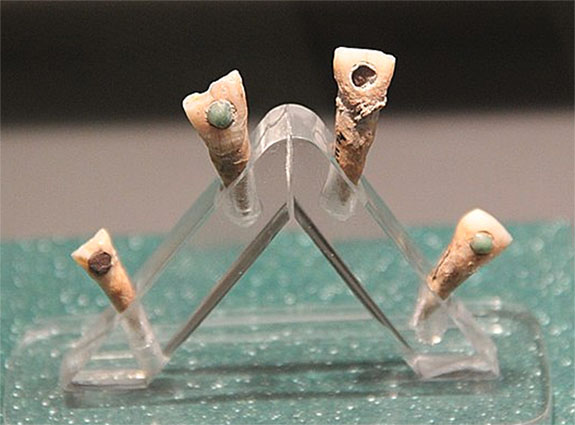Jewelry Blog Rockford, IL
Glue Used by Ancient Maya Dentists to Affix Gems to Teeth Delivers Bonus Benefit May 24, 2022
The ancient Maya are famous for erecting majestic palaces, sky-high pyramids and astronomical observatories, but did you know that they also loved to decorate their teeth with colorful gems and enjoyed excellent oral hygiene due to the all-natural glue dentists used to adhere the bling to their pearly whites?
The Maya civilization that spanned southeast Mexico, Guatemala, Belize, Honduras and El Salvador reached its pinnacle between 300 and 900 AD, and during that period, it was common for citizens — both rich and poor — to flash toothy smiles emblazoned with jadeite, iron pyrites, hematite, turquoise, quartz and serpentine.
Maya dentists expertly bored holes into tooth enamel and dentine and inlaid finely-shaped gems to fit the cavities. The dentists used plant-based sealants as adhesives, a technique so effective that most of the teeth recovered at Maya archaeological digs still have their stone inlays intact. The stones have held tight for more than 1,000 years.
Scientists originally believed that the Maya decorated their teeth for aesthetic or ritualistic reasons, perhaps marking a right of passage to adulthood.
But a team of researchers at the Center for Research and Advanced Studies of the National Polytechnic Institute in Mexico City believe that the glue-like sealant employed by dentists actually carried antibacterial properties and contributed to the society's excellent oral health. The researchers wrote that the ancient Maya believed "their breath was a link to the divine.”
Dr. Gloria Hernández Bolio and her colleagues analyzed sealants taken from eight teeth samples from different sites across the Maya empire. In all, they were able to identify 150 organic plant resin molecules, mostly from pine trees. Besides being an excellent dental adhesive, the pine resin attacks bacteria that causes tooth decay. Two of their samples contained sclareolide from Salvia plants. These are known to have antibacterial and antifungal properties.
The researchers emphasized how effective these ingredients were in promoting oral health. Study co-author, Vera Tiesler, a bioarchaeologist at the Autonomous University of Yucatán, explained that Janaab’ Pakal, the Maya king of Palenque, had nearly all of his teeth intact and none showed signs of decay when he died in 612 AD at the age of 80.
These findings were recently published in the Journal of Archaeological Science: Reports.
Credit: Image by https://www.flickr.com/photos/101561334@N08/, CC0, via Wikimedia Commons.
About the Author
With over 250 years of combined experience, our staff truly understands why you purchase jewelry, and what it means to you. Clodius & Co. is known as Rockford's custom jeweler and more. Why? Because we like to get acquainted with our customers while we help them select or create their jewelry.
Other Recent Blog Entries
Celebrate Every Kind of Dad – Watches & Handmade Gifts at Clodius & Co.
Gift with Purchase – A Special Valentine’s Offer
New Year, New Jewels: Start 2025 with Sparkling Style
The Enchanting World of Peridot: Discover Its Unique Beauty at Clodius & Co.
Honoring Independence Day with Clodius & Co Jewelry
Celebrate Mother's Day in Style: Inspiring Gift Ideas from Clodius & Co.
















